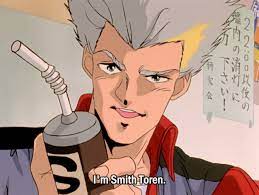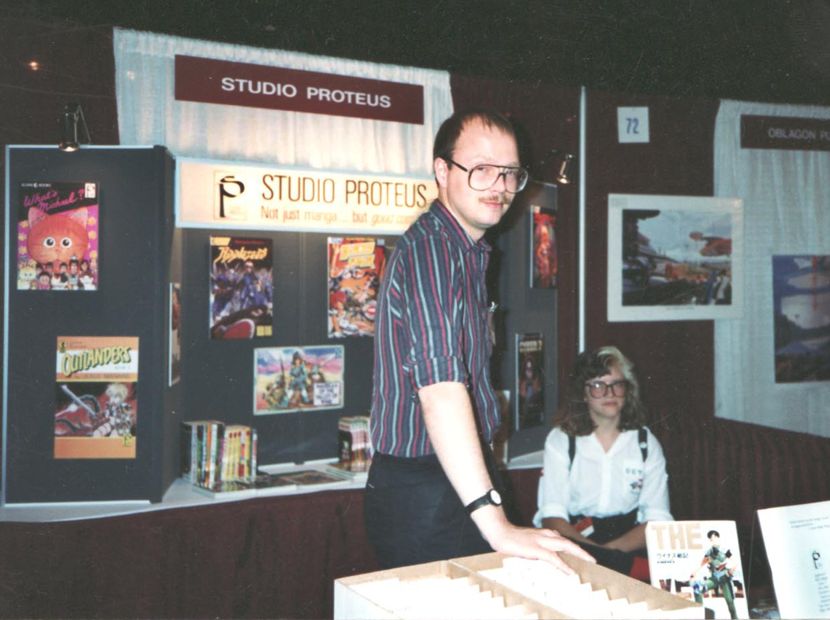Gunbuster Files: Smith Toren
July 16, 2023 · 0 comments
By Jonathan Clements.

Noriko Takaya, the leading lady in Gainax’s Gunbuster, gets her first unwelcome taste of battle in the episode “First Love, First Sortie.” But as the title implies, she also finds something else, in the form of her brief encounter with the handsome American pilot Smith Toren.
Toren Smith (1960-2013), for that was his real name, was actually Canadian, and when he died ten years ago, I was surprised how few people in anime and manga fandom had heard of him. In the 1980s, he was a pivotal figure in bringing manga to the United States, and hence the world. He would shuttle backwards and forward between Tokyo and San Francisco, taking those no-luggage options available to Fed Ex couriers, and over time, he and his future wife, Tomoko Saitou, would become the founders and leading lights of Studio Proteus, the manga company that brought Ghost in the Shell, Appleseed and many other titles to the English-speaking world.
I say “no luggage”. There was nothing in the rules about stuff in one’s pockets, however, so Toren would try to wear a whole season’s wardrobe all at once, looking not unlike Michelin Man as he shambled aboard the San Francisco flight.

But in the early days, he was very, very poor, and I remember him telling me that there was one point in his Japan days when he was practically starving and reduced to shoplifting instant noodles from a 7-11. And it was at that point that his friends from fandom stepped in, and Toshio Okada, who had met him at a Japanese science fiction convention, offered to let him move into the Gainax House.
The Gainax house was a rental dormitory that Gainax were using to put up many of their animators, and it was notoriously dirty. There were rows and rows of bunk beds, and trash that was never taken out, and terrible smells and mold in the kitchen. And Toren ended up living in a “room” that was actually a walk-in closet that they had put a bed into. And during the time that he was there, the people of Gainax were working on Gunbuster, and decided that they needed a handsome love interest.
As the days went by, the animators would come up to Toren and show him this figure developing on the page, and they would say to him “That guy is you!” He didn’t quite know what they meant until he turned up in the show, his confusingly arcane first-name inadvertently switched into a surname. Toren and Tomoko would actually end up also lending their voices to Gunbuster, turning up as panicking deck officers in a later episode, although I have never been able to pick them out from the crowd.
Toren’s best days were still ahead of him. Only a couple of years after the release of Gunbuster, in 1991, he helped organise an event in San Jose for which fans could get together to talk about Japanese cartoons. The name, in 1991, was AnimeCon. They didn’t need to call it anything else; there weren’t any others.

His Studio Proteus releases broke some of the biggest names in manga in the Western world, although in 2004 he gently extricated himself from much of the business, selling his licences to Dark Horse. He did so in part because he had witnessed the oncoming rush of pile-em-high, sell-em-cheap manga competitors and predicted (correctly) a slump in the market by 2006. The last time I saw him, we chomped our way through a huge Indian takeaway like two happy, fat Pacmen while I tried to explain to my wife how the man in front of her was also an anime pin-up, albeit with different hair, and body, and voice, and everything else.
On that occasion, he told me that he had made a point of going back to the Japanese 7-11 where he had once shoplifted a packed of noodles, and plunked down a sheaf of apologetic banknotes on the counter.
Jonathan Clements is the author of Anime: A History. Gunbuster is released in the UK by Anime Limited.
Leave a Reply